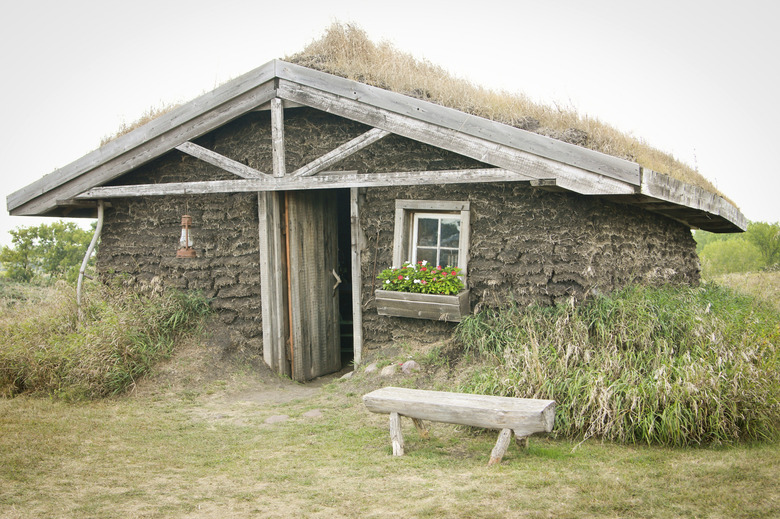How To Build A Model Sod House For A School Project
Homesteaders and settlers on the treeless plains of 19th century American territories were challenged to build homes without the wood construction techniques used in the northeastern United States. Understanding how settlers adapted to the environment of the plains can best be demonstrated by allowing children to construct their own "soddies" from readily available materials. Photographs and letters of the period can be referred to for crafting structures that simulate the difficulties of construction using the sod grass blocks cut from dense prairie grass.
Provide Photographs and Historic Background Resources
Provide Photographs and Historic Background Resources
Use old photographs of buildings and houses made of sod available online from the Library of Congress. Generate curiosity by asking children to consider how they would make a shelter without using wood. Encourage children to examine the construction of the houses, such as the staggered stacking of the sod bricks for walls and framing of doors and windows. Talk with children about the many skills needed to build a house sturdy enough to withstand severe winters.
Assemble Materials and Present the Challenge
Assemble Materials and Present the Challenge
In a microwave-safe bowl heat three tablespoons of butter and four cups of marshmallows on "high" for three minutes, stirring after two minutes. Stir until smooth. Add six cups of crispy rice cereal, stirring until all the cereal is coated. Quickly transfer mixture to a greased cookie sheet and press out into an even slab about half an inch thick. Toss one cup of dried and shredded coconut with several drops of green food coloring. Press a thin layer of coconut on top of the cereal and marshmallow rectangle. Allow to cool thoroughly, then cut into strips, then blocks that measure one by two inches. These will be the bricks which simulate sections of compressed dirt and grass originally used to construct a sod structure. Prepare a firm, flat surface for building and displaying the completed dwelling.
Steps of Construction
Steps of Construction
Invite children to stack these "sod bricks" to form a structure. Blocks should be placed coconut side down in much the same way the settlers stacked sod grass-side down. Remind children of the staggered stacking of bricks which will reinforce stability as the walls become taller. Caution children to think ahead if they want to leave space for windows and doors. Popsicle sticks cut to various lengths can be used to frame in these openings as the bricks continue to get stacked higher. These sticks left full length can also serve as supports over the top of the finished walls so sod bricks can be placed as roofing tiles. Display the colored coconut side on the roof to represent the growing, sprouting roof of the prairie soddy.
Finishing Touches
Finishing Touches
In keeping with photographs of the era, small figures representing the family can be placed in front of the house. Plastic figurines can be used from toy sets for this, or figures can be cut from cardboard, then colored with crayon or marker pens. The family's cow or horse can be included, and graham crackers or vanilla wafers can be crushed with a rolling pin and sprinkled around the soddy as simulated dirt. Provided the model was assembled with clean hands, the sod house model can now be consumed by the builders.
Cite This Article
MLA
Huson, Julie Alice. "How To Build A Model Sod House For A School Project" sciencing.com, https://www.sciencing.com/build-sod-house-school-project-7711279/. 24 April 2017.
APA
Huson, Julie Alice. (2017, April 24). How To Build A Model Sod House For A School Project. sciencing.com. Retrieved from https://www.sciencing.com/build-sod-house-school-project-7711279/
Chicago
Huson, Julie Alice. How To Build A Model Sod House For A School Project last modified March 24, 2022. https://www.sciencing.com/build-sod-house-school-project-7711279/
